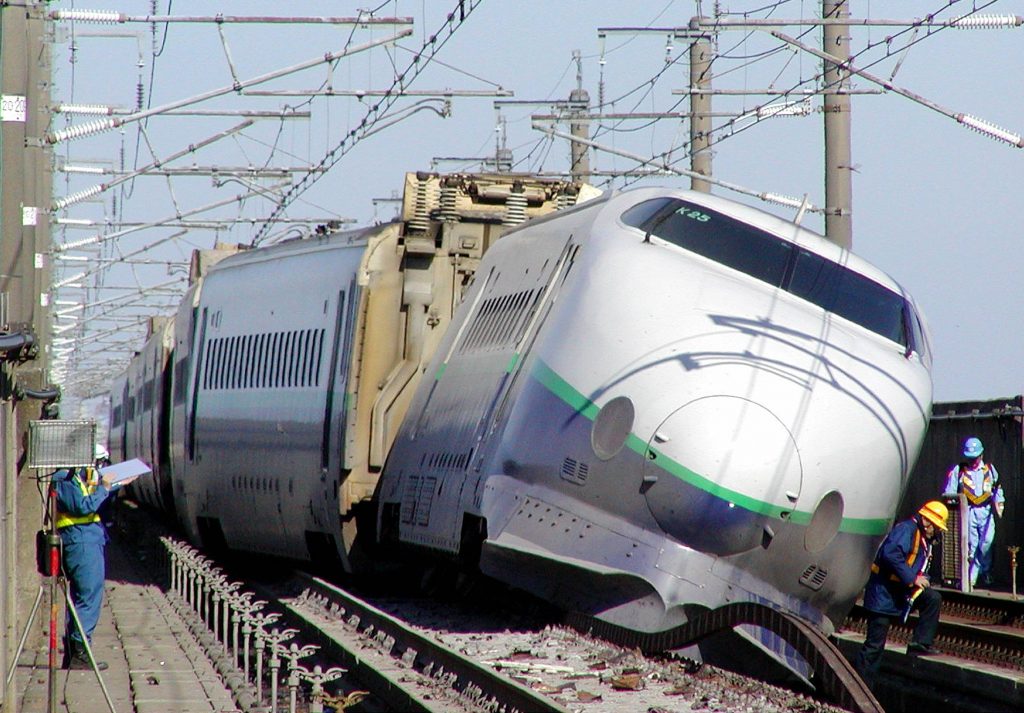
- ARAB NEWS
- 02 Jul 2025

Tokyo
An expert has praised East Japan Railway, or JR East, for preventing a Shinkansen bullet train from crashing during a powerful earthquake 15 years ago although the train derailed.
After the first derailment accident involving a Shinkansen train on commercial operations, some voiced criticism, saying that “the safety myth” of the highly acclaimed Japanese bullet train system collapsed.
But Yotaro Hatamura, 78, honorary professor at the University of Tokyo, rebutted. Before the temblor, JR East voluntarily carried out work to reinforce the rail section in question against earthquakes.
No one was killed or injured in the accident thanks to “a combination of the company’s honest efforts and good luck,” Hatamura, who independently investigated the accident site at the time, told Jiji Press recently.
The 6.8-magnitude earthquake occurred on the afternoon of Oct. 23, 2004, mainly hitting the Chuetsu region of Niigata Prefecture, central Japan.
Jolted by the temblor, the Toki No. 325 train on JR East’s Joetsu Shinkansen Line, which connects Tokyo Station and Niigata Station in the prefecture, derailed while it was traveling on elevated tracks between Urasa and Nagaoka stations, both in the prefecture, at a speed of about 200 km per hour.
But the train avoided a crash, as the elevated section did not collapse and the rails became stuck between the wheels of the train and parts on its body. All 154 passengers and crew members were safe.
The quake, which registered up to 7, the highest reading on the Japanese seismic intensity scale, killed nearly 70 people and injured some 4,800 others.
After the January 1995 earthquake in Kobe, the capital of the western prefecture of Hyogo, and surrounding areas, which also measured up to 7 and left more than 6,400 people dead or missing and some 43,000 others injured, the government instructed JR East and other Japan Railways Group companies to reinforce their facilities located in areas where large-scale earthquakes might strike.
The Chuetsu region was not included in the potential quake-prone areas. But JR East independently inspected an active fault located near the Joetsu Shinkansen tracks running in the region.
The railway operator then worked out a plan to reinforce a total of about 3,000 piers for elevated tracks in areas designated by the state and selected on its own that might collapse during earthquakes, according to Hatamura and others.
Among the sections subject to the reinforcement was the site of the derailment accident. JR East completed the work by the end of March 1999.
“If the elevated tracks had collapsed, the (Toki No. 325) Shinkansen train would have crashed, probably killing all aboard instantly,” Hatamura said. “We can save lives if we utilize all knowledge we have, estimate what will happen, and create plans and put them into action.”
Hatamura headed a government panel to investigate the March 2011 triple meltdown at Tokyo Electric Power Company Holdings Inc.’s tsunami-stricken Fukushima No. 1 nuclear power plant in northeastern Japan.
“Ultimately, what people working in an organization value, not technical matters, will become an issue. The TEPCO management team did nothing (to protect the nuclear plant from tsunami), without trusting data (that predicted huge tsunami hitting the plant in the event of a powerful earthquake).”
Meanwhile, Hatamura complained that once an accident happens in Japan, more weight is placed on pursuing individuals’ responsibility than on efforts to get to the bottom of the incident.
In the United States, it seems that responsibility of individuals is not questioned in principle, in order to make it easier for people involved in accidents to speak about them toward figuring out the truth regarding the incidents.
Hatamura said that Japan “must change its current system and way of thinking,” indicating that it is meaningless to get into conflict over whether somebody should be accused of an accident.
Jiji Press